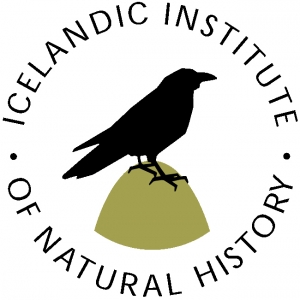PALEOGENE FLORAS OF WESTERN GREENLAND AND THE FAEROE ISLANDS AND THEIR RELATION TO MODERN MID-LATITUDE FLORAS: TESTING THE ARCTOTERTIARY HYPOTHESIS
Paleogene floras of western Greenland and the Faeroes
Project goals
Main objective of the project is to test the validity of Engler’s (1882) concept of the “arctotertiary element”, that is, to determine whether early Cenozoic high latitude floras were the cradle of tree genera now dominating north-temperate mid latitude forests. Furthermore, the climatic and ecological signals contained in these fossil floras will be used to reconstruct the environment that may have triggered the evolution of the “arctotertiary element”.
In order to achieve this
(1) the systematic affinities of pollen and spores from Paleocene (Danian and Selandian) sediments of western Greenland and Eocene (Ypresian) sediments of the Faeroe Islands will be established using modern approaches (light microscopy and scanning electron microscopy) to ensure high taxonomic resolution,
(2) existing museum and university collections containing macrofossils from the above mentioned areas will be studied and this will be complemented by collecting new material.
By combining evidence from the revised palyno- and macrofloras, the phylogenetic affinities of the investigated plant taxa will be established in order to determine the proportion of extinct lineages, distantly related to modern taxa, and co-occurring extant genera, representing the “arctotertiary element” in the studied floras.
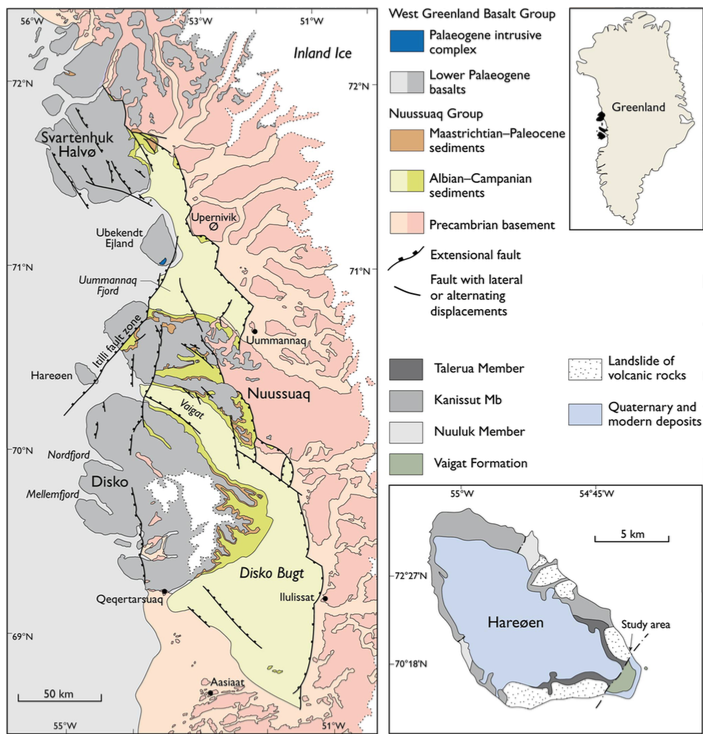
Maps showing part of the study area
Summary – English
Oldest records of many modern north-temperate woody angiosperm genera (trees and shrubs) are from the Eocene. However, the precise time and place of origin of individual tree genera, playing important roles in modern temperate forest ecosystems, has largely remained unresolved. One hypothesis about the origin of the temperate woody element in the northern hemisphere was proposed in the late 19th century by Adolf Engler, who suggested that many modern temperate tree genera originated in Arctic areas and migrated southwards in the course of the Cenozoic when global climate cooled. This idea has become unpopular during the second half of the 20th century and many fossil plant taxa from the early Cenozoic of high latitude regions are now considered belonging to extinct groups rather than to modern lineages. The idea of an “arctotertiary element” has been reignited by recent taxonomic revisions of early Cenozoic plant macrofossils from Spitsbergen and slightly younger fossils from Axel Heiberg Island. Pollen and spores are highly conservative plant organs and are diagnostic at the family and genus levels. Nevertheless, for many early Cenozoic localities at high latitudes, no modern palynological investigations, aiming at establishing the systematic and phylogenetic position of dispersed pollen and spores, have been carried out. The main objective of the proposed project is to test the validity of Engler’s (1882) concept of the “arctotertiary element”, that is, to determine whether early Cenozoic high latitude floras were the cradle of a number of tree genera that now dominate north-temperate mid-latitude forests. Furthermore, the climatic and ecological signals contained in these fossil floras will be used to reconstruct the environment that may have triggered the evolution of the “arctotertiary element”. To achieve this, the systematic affinities of pollen and spores from Paleocene (Danian and Selandian) sediments of western Greenland and Eocene (Ypresian) sediments of the Faeroe Islands will be assessed using modern approaches (light and scanning electron microscopy) to ensure high taxonomic resolution. Macrofossils from the same areas housed in existing museum and university collections will be studied, and new material will be collected in the field. By combining evidence from the revised palyno- and macrofloras, the phylogenetic affinities of the recognized plant taxa will be established in order to determine the proportion of extinct lineages, distantly related to modern taxa, and co-occurring extant genera, representing the “arctotertiary element” in the floras studied. For a number of widespread north -temperate tree genera, it will be established whether they originated in Arctic regions and subsequently migrated southwards, or whether the migration from high-latitude regions to more southern areas represented a secondary migration. The potential role of Arctic areas as source area for younger mid-latitude and modern floras will be assessed.
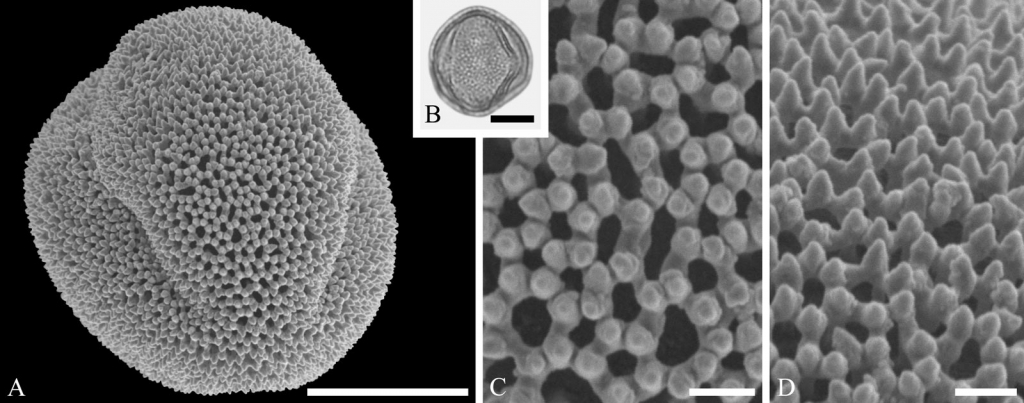
Icacinaceae pollen from the early Paleocene of Agatdalen, western Greenland
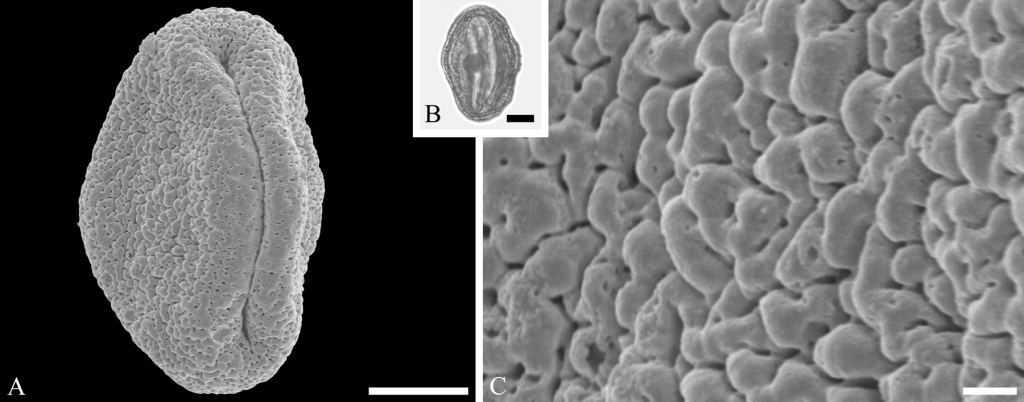
Mastixia pollen from the early Paleocene of Agatdalen, western Greenland
Summary – German
Der Fossilbefund zahlreicher angiospermer Baumgattungen der nördlichen temperierten Zone geht bis ins Eozän zurück. Der genaue Zeitpunkt und Ort ihrer Entstehung ist jedoch weitgehend immer noch unbekannt. Im ausgehenden 19. Jhdt. wurde von Adolf Engler die Hypothese des „arktotertiären Elementes“ eingeführt. Demnach lassen sich zahlreiche Baumgattungen der nördlichen temperierten Zone von Vorläufer ableiten welche dem Alttertiär der Arktis entstammen und von dort im Zuge einer globalen Klimaabkühlung nach Süden abwanderten. Insbesondere gehören dazu Baumgattungen, die heute die temperierten Waldökosysteme dominieren (z.B. Ahorn, Birke, Buche und Eiche). In der 2. Hälfte des 20. Jhdt. verlor diese Hypothese an Aktualität. Gegenwärtig werden die fossilen Pflanzentaxa des arktischen Alttertiärs ausgestorbenen Gruppen zugeordnet, die, wenn überhaupt, nur entfernte Verwandte der heute dominierenden temperaten Gehölze sind. Jüngste Revisionen alttertiärer Floren von Spitzbergen und der Axel-Heiberg-Insel führten zu einer Renaissance des Arktotertiärbegriffes. Sporen und Pollen gelten als merkmalskonservative Pflanzengenerationen mit hoher diagnostischer Relevanz auf Familien- und Gattungsebene. Nichtsdestotrotz fehlen für viele frühkänozoische Lokalitäten der hohen Breite moderne palynologische Bearbeitungen, welche zum Ziel haben dispergierte Sporen und Pollen in einen klaren systematischen Zusammenhang zu stellen. Das Hauptziel des Projekts wird daher sein, Englers Konzept der „arktotertiären Elemente“ an Hand ausgewählter altpaläozäner und alteozäner Fundstellen zu überprüfen. Dabei ist die zentrale Frage, ob die modernen, heute dominierenden, temperaten Gehölzgattungen mit hoher Zuverlässigkeit bis in das Paläozän der Arktis nachgewiesen werden können. Ist die Arktis die Wiege einiger moderner Gehölze der mittleren Breiten? Darüber hinaus werden an Hand der fossilen Pflanzengesellschaften die ökologischen und klimatischen Rahmenbedingungen ermittelt, die als Auslöser der Entstehung und Radiation der „arktotertiären Elemente“ in Frage kommen. Zur Beantwortung dieser Fragen, werden die Sporen und Pollen des Paläozäns (Danium, Seelandium) Westgrönlands und des Eozäns (Ypresium) der Färöer mit Hilfe moderner Methoden (kombinierte licht- und rasterelektronen¬mikroskopische Untersuchungen) systematisch bearbeitet um eine möglichst hohe taxonomische Auflösung und Präzision zu gewährleisten. Diese Untersuchungen werden von entsprechenden Arbeiten an Makrofossilien begleitet, die an Hand vorhandener umfangreicher Museumssammlungen und neuaufgesammelten Materials durchgeführt werden. Mit Hilfe des palynologischen und makrofossilen Befunds wird die phylogenetische Position der gefundenen Fossilien im Hinblick auf moderne Gattungen und Familien festgestellt. In diesem Zusammenhang wird der Anteil ausgestorbener und moderner, potentiell „arktotertiärer“, Elemente erfasst. Für letztere werden potentielle Arealentwicklungen rekonstruiert, wobei zwischen solchen Elementen unterschieden werden soll, welche primär in der Arktis entstanden und in der Folgen nach Süden ausgewandert sind, den „arktotertiären Elementen“ Englers, und solchen, die ursprünglich aus anderen Gebieten in die arktischen Breiten eingewandert sind und dann sekundär ihr modernes Verbreitungsgebiet in der temperierten Zone etabliert haben.
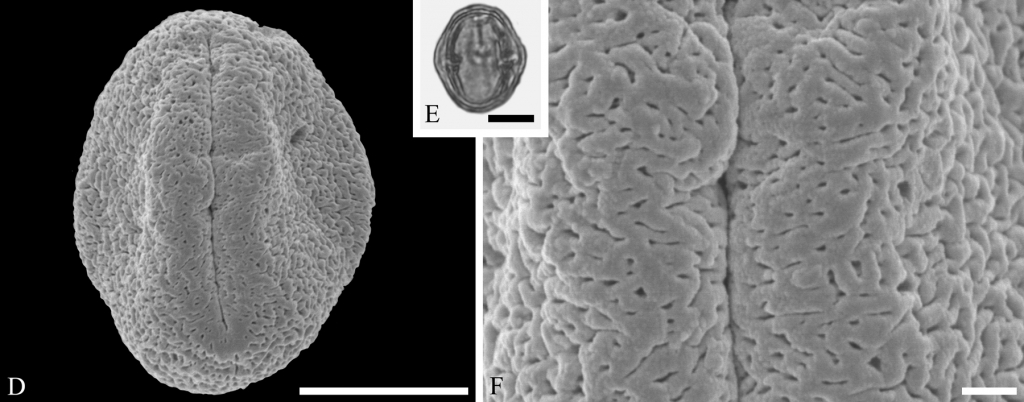
Araliaceae pollen from the early Paleocene of Agatdalen, western Greenland
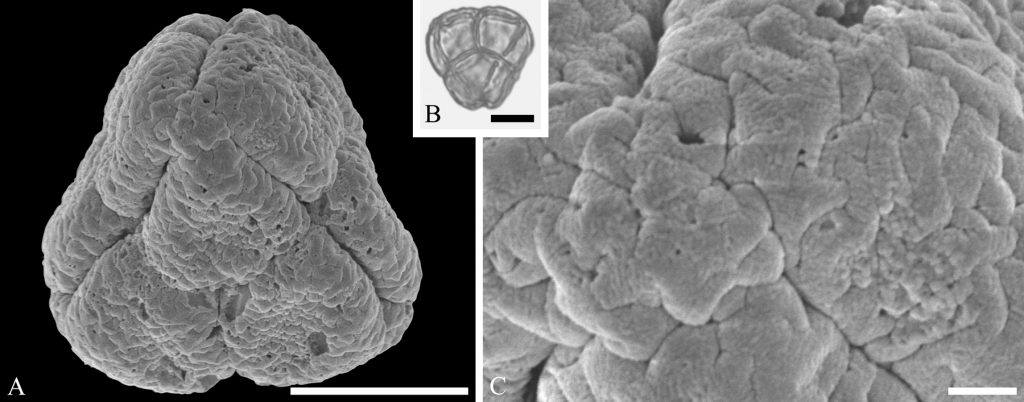
Ericaceae pollen from the early Paleocene of Agatdalen, western Greenland
Participants / Collaborators / Co-authors
Project output
Articles
Friðgeir Grímsson, Guido W. Grimm, Alastair J. Potts, Reinhard Zetter, Susanne S. Renner. 2018. A Winteraceae pollen tetrad from the early Paleocene of western Greenland, and the fossil record of Winteraceae in Laurasia and Gondwana. Journal of Biogeography 45, 567-581.
Friðgeir Grímsson, Guido W. Grimm, ReinhardZetter. 2018. Evolution of pollen morphology in Loranthaceae. Grana 57, 16-116.
Friðgeir Grímsson, Alexandros Xafis, Frank H. Neumann, Reinhard Zetter. 2017. Pollen morphology of extant Winteraceae: a study allowing SEM-based affiliation of its fossil representatives. Acta Palaeobotanica 57, 339-396.
Friðgeir Grímsson, Guido W. Grimm, Reinhard Zetter. 2017. Tiny pollen grains: first evidence of Saururaceae from the Late Cretaceous of western North America. PeerJ 5, e3434.
Friðgeir Grímsson, Paschalia Kapli, Christa-Carlotte Hofmann, Reinhard Zetter, Guido W. Grimm. 2017. Eocene Loranthaceae pollen pushes back divergence ages for major splits in the family. PeerJ 5, e3373.
Friðgeir Grímsson, Reinhard Zetter, Conrad C. Labandeira, Michael S. Engel, Torsten Wappler. 2017. Taxonomic description of in situ bee pollen from the middle Eocene of Germany. Grana 56, 37-70.
Friðgeir Grímsson, Gunver Krarup Pedersen, Guido W. Grimm, Reinhard Zetter. 2016. A revised stratigraphy for the Palaeocene Agatdalen flora (Nuussuaq Peninsula, western Greenland): correlating fossiliferous outcrops, macrofossils, and palynological samples from phosphoritic nodules. Acta Palaeobotanica 56, 307-327.
Friðgeir Grímsson, Guido W. Grimm, Reinhard Zetter, Thomas Denk. 2016. Cretaceous and Paleogene Fagaceae from North America and Greenland: evidence for a Late Cretaceous split between Fagus and the remaining Fagaceae. Acta Palaeobotanica 56, 247-305.
Torsten Wappler, Conrad C.Labandeira, Michael S.Engel, Reinhard Zetter, Friðgeir Grímsson. 2015. Specialized and generalized pollen-collection strategies in an ancient bee lineage. Current Biology 25, 3092-3098.
Steven R. Manchester, Friðgeir Grímsson, Reinhard Zetter. 2015. Assessing the fossil record of asterids in the context of our current phylogenetic framework. Annals of the Missouri Botanical Garden 100, 329-363.
Friðgeir Grímsson, Reinhard Zetter, Guido W. Grimm, Gunver Krarup Pedersen, Asger Ken Pedersen, Thomas Denk. 2015. Fagaceae pollen from the early Cenozoic of West Greenland: revisiting Engler’s and Chaney’s Arcto-Tertiary hypotheses. Plant Systematics and Evolution 301, 809-832.
Friðgeir Grímsson, Reinhard Zetter, Heidemarie Halbritter, Guido W. Grimm. 2014. Aponogeton pollen from the Cretaceous and Paleogene of North America and West Greenland: Implications for the origin and palaeobiogeography of the genus. Review of Palaeobotany and Palynology 200, 161-187.
Abstracts
Steven R. Manchester, Kathleen Pigg, Richard Dillhoff, Friðgeir Grímsson, Zlatko Kvaček. 2018. Biogeographic patterns in the history of Trochodendraceae. 10thEuropean Palaeobotany-Palynology Conference. Program & Abstracts, p. 76.
Friðgeir Grímsson, Christa-Charlotte Hofmann, Reinhard Zetter. 2015. Paläobotanische Untersuchungen auf der Insel Mykines (Färöer Inseln): Spät-Paläozäne Blattfunde und Pollen. 21. Jahrestagung der Österreichische Paläontologischen Gesellschaft, p. 9.
Louise Beck, Jan Audun Rasmussen, Friðgeir Grímsson 2014. Unravelling the Macclintockia species complex from the Paleocene of West Greenland. 9th European Palaeobotany-Palynology Conference. Abstract Book, p. 14-15.
Thomas Denk, Friðgeir Grímsson, Reinhard Zetter. 2014. Origins of the north-temperate tree flora: revisiting Engler’s concept of the Arcto-Tertiary element. 9th European Palaeobotany-Palynology Conference. Abstract Book, p. 52.
Friðgeir Grímsson, Reinhard Zetter, Thomas Denk. 2014. Revision of the early Cenozoic macrofloras from West Greenland reveal the actual age and floral elements of Oswald Heer´s (1868-1883) classic Upper Atanikerluk “Miocene” floras. 9th European Palaeobotany-Palynology Conference. Abstract Book, p. 87.
Friðgeir Grímsson, Reinhard Zetter, Gunver Krarup Pedersen, Asger Ken Pedersen, Thomas Denk. 2014. Middle Eocene palynoflora from a resinite-rich coal bed on Hareøen (Qeqertarsuatsiaq), West Greenland. 9th European Palaeobotany-Palynology Conference. Abstract Book, p. 86.
Friðgeir Grímsson, Bartal Højgaard, Christa-Charlotte Hofmann, Christian Pott, Guido W. Grimm, Grímur Rúnar Friðgeirsson, Thomas Denk, Reinhard Zetter. 2014. Revisiting the late Paleocene Mykines macrofossil site, Faeroe Islands. 9th European Palaeobotany-Palynology Conference. Abstract Book, p. 85-86.
Christian Pott, Friðgeir Grímsson, Reinhard Zetter, Maria Tekleva. 2014. Cycas-like pollen from the Eocene of West Greenland. 9th European Palaeobotany-Palynology Conference. Abstract Book, p. 218.
Christian Pott, Friðgeir Grímsson, Christa-Charlotte Hofmann, Guido W. Grimm, Grímur Rúnar Friðgeirsson, Thomas Denk. 2014. First Ginkgo leaf fossils from the Faroe Islands. 9th European Palaeobotany-Palynology Conference. Abstract Book, p. 217.
Reinhard Zetter, Friðgeir Grímsson. 2014. Early Paleocene palynoflora from nodular phosphorites of the Nuussuaq Peninsula, West Greenland. 9th European Palaeobotany-Palynology Conference. Abstract Book, p. 317-318.
Reinhard Zetter, Friðgeir Grímsson, Christa-Charlotte Hofmann, Guido W. Grimm. 2014. Paleogene Loranthaceae pollen from West Greenland and Eurasia. 9th European Palaeobotany-Palynology Conference. Abstract Book, p. 318.
Presentations
08/2018 –10thEuropean Palaeobotany-Palynology Conference, Dublin, Ireland. Talk in special session 13. Title: Biogeographic patterns in the history of Trochodendraceae. Speaker: Steven R. Manchester.
11/2015 – Venia Docendi (Priv.-Doz.) / Doctor Habilitatus talk, University of Vienna. Title: Frühe känozoische Floren Grönlands und der Färöer Inseln. Speaker: Friðgeir Grímsson.
03/2015 – University of Vienna, Division of Structural and Functional Botany Seminar Series. Title: Early Paleocene palynoflora from Agatdalen, West Greenland. Speakers: Friðgeir Grímsson & Reinhard Zetter .
08/2014 – 9th European Palaeobotany-Palynology Conference, Padova, Italy. Talk in session S19. Title: Middle Eocene palynoflora from a resinite-rich coal bed on Hareøen (Qeqertarsuatsiaq), West Greenland. Speaker: Friðgeir Grímsson.
08/2014 – 9th European Palaeobotany-Palynology Conference, Padova, Italy. Talk in session S19. Title: Early Paleocene palynoflora from nodular phosphorites of the Nuussuaq Peninsula, West Greenland. Speaker: Reinhard Zetter.
08/2014 – 9th European Palaeobotany-Palynology Conference, Padova, Italy. Talk in session S19. Title: Origins of the north-temperate tree flora: revisiting Engler’s concept of the Arcto-Tertiary element. Speaker: Thomas Denk.
03/2014 – Natural History Museum London, Earth Sciences Department Seminar Series. Title: Paleogene floras of western Greenland and the Faeroes – Geology / Macrofossils / Pollen – Preliminary results. Speaker: Friðgeir Grímsson.
07/2013 – Jarðfeingi, Faroese earth and Energy Directorate. Title: Paleogene floras of western Greenland and the Faeroes. Speaker: Friðgeir Grímsson.
06/2012 – SYNTHESYS talk, Swedish Museum of Natural History. Title: First steps in “revising” the Paleogene floras of western Greenland and the Faroe Islands. Speaker: Friðgeir Grímsson.






